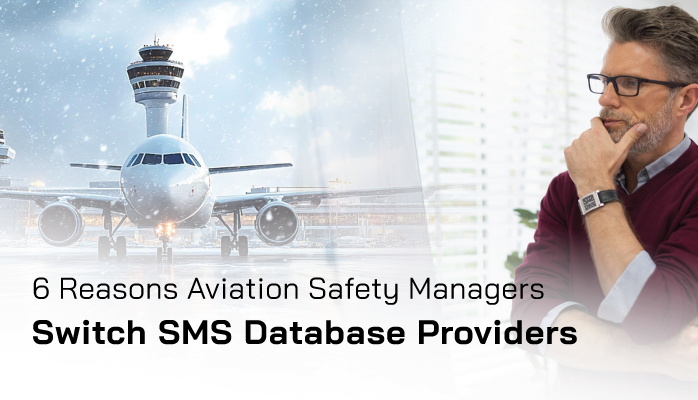SMS Database Providers

Aviation safety management systems (SMS) are the backbone of safe and compliant operations for
- airlines,
- airports,
- aviation maintenance providers, and
- other aviation service providers.
Since the International Civil Aviation Organization (ICAO) mandated SMS implementation in 2006, safety managers have relied on spreadsheets and SMS databases to manage vast amounts of safety data, ensure regulatory compliance, and foster a proactive safety culture. However, not all SMS database providers are created equal. If your current provider is falling short, it’s time to consider switching. Here are six compelling reasons why aviation safety managers should switch SMS database providers to enhance safety, efficiency, and operational success.
1. Enhanced Data Management and Scalability
Modern aviation operations generate mountains of safety-related data, from incident reports to hazard analyses. Legacy SMS databases, often built integrating outdated platforms like spreadsheets or in-house solutions, struggle to handle this volume efficiently.
A robust, commercial-off-the-shelf (COTS) SMS database offers superior data management, enabling safety managers to organize, retrieve, and analyze data seamlessly. These systems are scalable, accommodating growing operations without compromising performance. Switching to a provider with advanced data handling capabilities ensures your SMS evolves with your organization, preventing bottlenecks and data silos that hinder safety assurance.
Related Aviation Safety Database Articles
- What Is an Aviation Safety Database
- 5 Most Important Things to Know Before Buying Aviation SMS Database
- How to Choose the Best Aviation Safety Database Software
2. Improved Regulatory Compliance
Compliance with ICAO, FAA, and EASA regulations is non-negotiable. However, outdated or poorly designed SMS databases can make compliance a nightmare, especially during SMS regulatory audits.
Modern SMS database providers offer features like
- automated workflows,
- SMS training delivery and management,
- audit trails, and
- real-time reporting that align with regulatory requirements.
For instance, FAA Part 5 mandates processes for safety performance monitoring, which sophisticated databases streamline through integrated dashboards and safety performance indicators (SPIs). Switching to a provider that prioritizes compliance reduces audit stress and ensures your SMS meets global standards.
By adopting a provider with compliance-focused tools, safety managers can avoid penalties and demonstrate a commitment to safety excellence.
3. Cost-Effectiveness for Small and Large Operators

Budget constraints are a common challenge, particularly for smaller operators. Surprisingly, sticking with an inadequate SMS database can be costlier in the long run due to
- inefficiencies,
- missed opportunities for continuous improvement,
- audit failures, or even
- preventable safety incidents.
Modern COTS SMS databases are affordable, with some providers offering plans as low as $200 monthly for comprehensive services. These solutions eliminate the need for expensive in-house development, which can cost millions. Switching to a cost-effective provider delivers enterprise-grade features without breaking the bank, making it a smart investment for operators of all sizes.
4. Proactive Hazard Identification and Risk Management
A core pillar of SMS is proactive hazard identification and risk management. Legacy systems, such as spreadsheet-based SMS, lack the analytical tools needed to predict and mitigate risks effectively.
Advanced SMS databases integrate predictive analytics, enabling safety managers to identify trends, assess risks, and implement corrective actions before issues escalate. For example, a provider with proactive hazard analysis tools can help map out SMS requirements, ensuring no hazard goes unnoticed. Switching to a provider with these capabilities strengthens your SMS’s proactive approach, enhancing safety outcomes.
Proactive tools empower safety managers to stay ahead of risks, protecting passengers, staff, and reputations. Consequently, safety managers deliver more safety services to the organization, such as safety newsletters, safety surveys and other safety promotion activities.
Related Proactive Safety Risk Management Articles
- Difference Between Reactive, Predictive and Proactive Risk Management in Aviation SMS
- Reactive or Proactive Safety Culture? 5 Creative Ways to Tell
- 3 Things You Are Doing to Hurt Proactive Risk Management in Aviation SMS
5. Streamlined Management of Change (MOC) Processes
Operational changes, such as new routes or aircraft types, require meticulous management of change (MOC) processes to maintain safety. Many older SMS databases lack dedicated MOC modules, forcing safety managers to rely on manual processes that are prone to errors and overlook hazards.
Modern providers offer template-driven MOC workflows that guide teams through hazard analyses, risk assessments, and post-implementation monitoring. Switching to a provider with robust MOC tools like SMS Pro ensures changes are managed systematically, reducing risks and enhancing safety assurance.
6. Fostering a Strong Safety Culture
A strong safety culture relies on employee engagement and trust in hazard reporting systems. If your current aviation SMS database is clunky, slow or lacks user-friendly features, employees may hesitate to report issues, undermining your safety culture.
Modern aviation SMS databases offer intuitive interfaces, mobile access, non-punitive reporting tools and automated feedback mechanisms that encourage staff participation. For instance, confidential reporting systems boost trust, while automated notifications keep teams informed based on their role or position within the SMS. Switching to a provider that prioritizes user experience fosters a safety-first mindset across your organization.
An engaged workforce is the foundation of a high-performing SMS, and the right database provider makes it happen.
Why Now Is the Time to Switch
The aviation industry is evolving rapidly, with increasing regulatory scrutiny and technological advancements. Sticking with an outdated or underperforming SMS database provider puts your organization at risk of non-compliance, inefficiencies, and safety lapses. By switching to a modern, industry-accepted provider, safety managers can unlock benefits like:
- Seamless integration with existing quality management systems (QMS).
- Real-time dashboards for data-driven decision-making.
- Automated SMS training delivery for initial and recurrent SMS training.
- Reduced administrative burden through automation.
- Enhanced reputation for safety and reliability.
- Peace of mind that your SMS database evolves with changing regulatory requirements.
Don’t let an inadequate SMS database hold your organization back. Evaluate your current provider against these six criteria and consider a switch to a solution that aligns with your safety and business goals.
Conclusion
Aviation safety managers are tasked with protecting lives, ensuring compliance, and driving operational excellence. An outdated or ineffective SMS database can hinder these efforts, making it critical to switch to a provider that offers
- scalability,
- compliance,
- cost-effectiveness,
- proactive tools,
- MOC support, and
- a strong safety culture.
By making the switch, you’ll position your organization for long-term success in a competitive and safety-critical industry. Take the first step today—review your SMS database provider and explore modern solutions that empower your safety program.
Ready to switch? Contact SMS Pro to request demos and find the perfect fit for your aviation safety needs.







